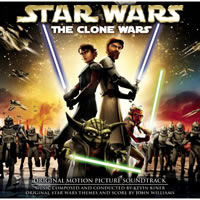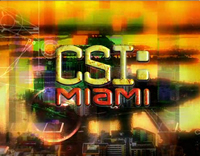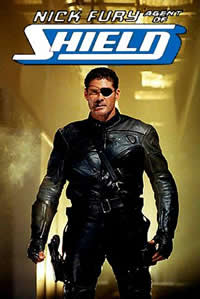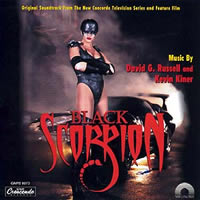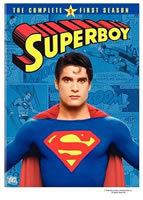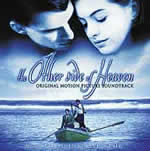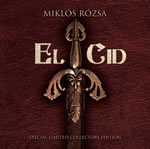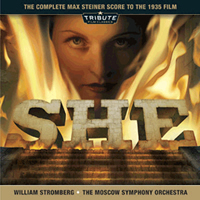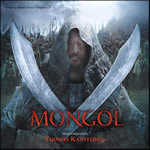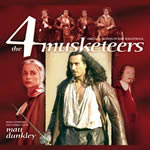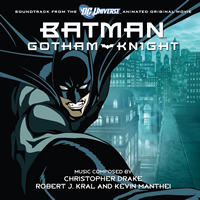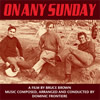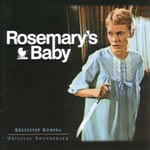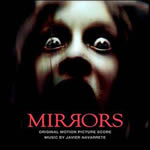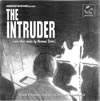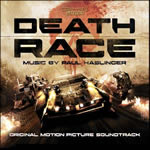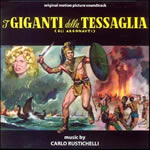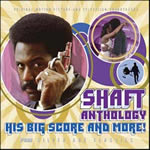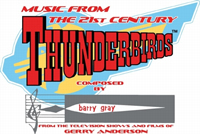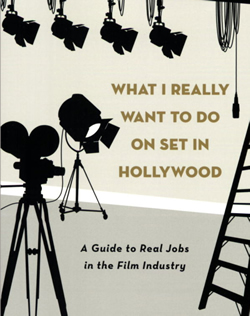 |
Soundtrax: Episode 2008-15
August 18, 2008
By Randall D. LarsonExpanding the Star Wars Universe: Kevin Kiner in the Clone Wars
This week we interview Kevin Kiner whose masterful incarnation of John Williams makes the animated feature, The Clone Wars, very much a part of the Star Wars oeuvre. Kiner, one of the most underrated composers in Hollywood whose 25+ year career has resulted in numerous fine works, discussed his evocation of Williams and why scoring The Clone Wars was so important to him. We also discuss several of Kiner’s other scores including Wing Commander, Leprechaun, and CSI: Miami.We have a ton of reviews from new and recent releases: Tadlow’s expanded and complete recording of Miklos Rozsa’s El Cid (“allows its variegated nuances to be more fully explored and appreciated”), Tribute’s new presentation of Max Steiner’s classic score for 1935’s adventure fantasy She (“allows Steiner’s breathtaking composition… to be expressed in its fully intended scope”), Tuomas Kantelinan’s exotic historical epic, Mongol (“a richly evocative score, lyrically convincing and effectively textured for the period”), Matt Dunkley’s eloquent swashbuckling score for a new French movie about The 4 Musketeers (“a thoroughly winning composition featuring several great themes for orchestra and choir”), the dark soundtrack for the new anime feature, Batman: Gotham Knight (“focuses on the darker side of the Batman psyche”), a rare Dominic Frontiere score, 1971’s dirt bike documentary, On Any Sunday (“comprised of likable guitar laden pop sensibilities and very much in the lounge-pop vogue of the era”), a corrected and slightly expanded version of Krzystof Komeda’s haunting score for Rosemary’s Baby (“expands the haunting score further beyond the original 12-track Dot LP version issued at the time of the film”), Javier Navarrete’s spooky reflective music for Mirrors (“Navarrete’s layered orchestration is consistently interesting and the score’s incorporation of Albéniz’s ‘Asturias’ lends an urgency that is quite potent and effective”), a recovered minor classic, Herman Stein’s music for Roger Corman’s ambitious racism drama, The Intruder (“inventively scored for mostly short motifs, devoid of a central recurring theme, arranged to make the most of its miniscule orchestra of only 20 players”), Paul Haslinger’s gritty, rock-based score for Death Race (“Haslinger’s music is edgy and brutal, its guitar-laden strains lending both an appropriate aural association for a car movie while heightening the film’s sense of drive, muscle, and speed”), and Carlo Rustichelli’s powerful epic score for 1960’s Giants of Thessaly (“epic in scope and operatic in style, highlighted by a majestic, melodic main theme given numerous variations for orchestra, choir, even solo organ, resonating with adventure, action, pathos, or mysterioso”).
Plus great news from the soundtrack front on forthcoming soundtracks to Buffy, Blazing Saddles, TV’s Eureka, a huge new 20-score box set from FSM, and the first release of library music from Shaw Bros kung-fu classics of the 70’s.
Kevin Kiner Interview: Kevin Kiner
Star Wars: The Clone Wars brings the Star Wars universe to life in a vividly animated new feature film directed by Dave Filoni (Avatar The Last Airbender) that also serves to debut the ensuing television series of the same name that debuts later this year (set in the same world as the 2003-2005 Clone Wars series but helmed by a different staff). Composer Kevin Kiner (Leprechaun, Wing Commander, CSI: Miami) has composed a thunderous score for the new Clone Wars animated feature, which in its opening moments immediately brings the listener/viewer into the familiar Star Wars universe but, especially with its slower cadence and earthier texture, resonates as something distinctly different. The soundtrack album, released this week by Sony Classical, is a splendid composition, beautifully performed, that’s one third pure Williams, one third Williams interpreted by Kiner, and one third pure Kiner – and one hundred percent a must-have soundtrack for anyone dazzled by the film music of Star Wars and its ilk. Investing the score with a variety of ethnic textures and percussive rhythms, Kiner’s Clone Wars is a deeply carved Star Wars clone that manages to be a satisfactory doppelganger of Williams while at the same time emerging as a serious and significant composition of its own.
Q: What does a composer have to do to prepare oneself for scoring The Clone Wars, with all the legacy that’s involved with the Star Wars films and the music?
Kevin Kiner: I think it’s actually really great that I didn’t have to! If there was any preparation involved, it was my life experience, as being a huge fan. I had bought John Williams’ scores, the physical paper scores, when they came out and analyzed them, never with the thought that I would do that someday, just with the thought that I wanted to understand his magic and his thinking process. So that was my preparation.
Q: How did you get the job to score The Clone Wars?
Kevin Kiner: Somehow my CD got included with quite a few other composers who auditioned for the gig. I would imagine it was because of my background, and my sci-fi things…
Q: And obviously your capability with orchestra music…
Kevin Kiner: The funny thing is, I think my music for CSI: Miami played almost a bigger part than anything else. I think George Lucas really liked the soundtrack to that show, because it’s really cutting edge, it’s real young, it’s very what’s-happening-now, and I think he wanted to do that with this film.
Q: When you first begin to tackle the project, how did you decide how to integrate the John Williams themes and yet make the score your own?
Kevin Kiner: Let me speak to the theme, first, because that was the biggest challenge. This is one of the greatest themes written in the history of cinema. I mean, aside from Yao Ming, this might be the most recognizable thing on the planet! Everybody knows the Star Wars Theme. So it was very daunting, and George really wanted to take it in a big, percussive way. That was his big take: let’s be ethnic, let’s be percussive, and so I tried to do that and I battled for days and days on it. The best thing that happened to me was just taking it out of its own time signature, because it has this march time signature, in 2/2, and when you get the big drums that we wanted to use going in the original time signature, it kind of becomes disco or something like it! It just becomes pedantic. It’s not the right thing, and it’s not what John did at the beginning. So I had to change the time signature from 2/2, which is how John wrote it, and take it into 5/4 and then all the drums can bash their way into things and not feel like disco because it’s kind of irregular and yet it still serves the melody.
Q: How did the score develop from there?
Kevin Kiner: George was very keen on using more ethnic idioms. He wanted each planet to have its own ethnicity, and that’s completely his concept. After a while, you know, space chords or space music becomes cliché. So we’re not going to be “space music,” we’re going to be “ethnic music.” Now we’re on this planet, and it’s like Peru. So now we have all the charangos, and we have the pan flute, and all of these Peruvian instruments that are playing. Then we go to this other planet, where it needs Egypt! Now we have the duduk and the oud, or this planet that has a Bulgarian women’s choir, and so on. I tried to use these instruments in a really authentic manner, performed by players who really know the music of their countries; I didn’t just use studio players.
Q: I’ve always felt that science fiction music and fantasy film music, uniquely among genres, not only has to support the visual drama and emotion of a film, but also it has this responsibility of almost creating the environment, which is often something very alien and otherworldly. You’ve literally had that opportunity in Clone Wars, in the case of these different planets, where the music really sets the tone for these environments.
Kevin Kiner: You’re exactly right. It’s the whole job of the music, and what we were trying not to be was clichéd alien music. I mean, back ten, fifteen, twenty years ago, it was great to hear that music, because it meant “aliens.” But now, that’s kind of been done and that feels just like bellbottom pants don’t feel right! They were great back then …
Q: I wore mine proudly!
Kevin Kiner: I did too! I even had the platform shoes! But we kind of don’t do that anymore, and we’re trying to find a different way to give that same feeling. I think George has hit on a brilliant thing with the ethnicity and doing it with ethnic stuff rather than with “space chords.”
Q: It’s almost like, since Star Wars has become such a musical icon in the annals of film music, returning us to the symphonic scoring idiom that had been going out of style at that time, and it’s almost like your responsibility here in Clone Wars is that the music needs to be familiar to an extent, but it needs to be different and take it in a slightly different direction, as does the style of the animation and the story. How conscious were you of all that and what kind of road map did you feel you had to follow to integrate John’s themes, your own themes, and the ethnic music throughout this score as it went along.
Kevin Kiner: I was hugely conscious of that. I’m hugely conscious of John Williams creating one of the great, seminal works in the history of film, and there’s nothing that can ever be taken away from what he did. All I can do is try to be something a bit different, and yet harken back to what he did. I don’t want to take people out of the Star Wars universe, and the Star Wars universe musically has a John Williams feel to it, so I have to still use some of his techniques. At the same time, I have to advance it a bit, or I have to ethnicize it, or I have to change it for what this show is. That’s been a huge job, and basically that’s kept me up all night for the last two years! It’s been a daunting process. That’s like saying “make Beethoven better!”
Q: At the same time, I guess you can say, “you need to be Williams but you don’t have to be exactly Williams.” You’re allowed to be Kevin Kiner on this thing. With that in mind, how have you been able to invest your own voice into the score and make it more your own?
Kevin Kiner: I think that’s actually the cool thing, is that I didn’t have to be him. I’ve always wanted to be a bit of him, and I think I always will have a bit of him in me, because he’s just one of my great heroes. It’s just like somebody who’s grown up playing Charlie Parker licks, he’ll always have a bit of Charlie Parker in him. But at the same time, I really wanted to be me, and I think George was the great hero in this whole thing, telling me “do whatever you want.” So I got to be a bit of John and a bit of me. I can’t describe how I melded a bit of John with a bit of me, but that was the idea. I hope that comes across in the score. I think I’ve captured some of the flourishes and the melodies and the grooves and some of the things that he made famous in the show, but I think I’ve also taken them in my own direction as well.
Q: How would you describe your technique at scoring the action scenes, which are obviously a big part of the score and a big part of the film?
Kevin Kiner: As with any animation, the action is joined at the hip with the music. It’s totally melded. I’ve done quite a bit of animation, so I guess I’m a bit used to that. I would say my technique is just to go second by second and see where things are changing and where I should change. I kind of make a roadmap, at first… I see that this is Grievous here, so I should be Grievousing. Here’s where Annakin comes in, and here’s where Ahsoka comes in, and I would try to incorporate their themes with them. But, in the TV series, we also have themes that are become of the themes of the episode, and the theme of this episode might be “espionage,” so now I have to introduce that. There are quite a few elements, and so I will look at a scene and just pick my spots. I’ll say, “Okay, this is really important to be Annakin, and this is really important that we emphasize the espionage factor here because this is an espionage show, and it’s really important that we have Grievous’s theme here. At the same time, I have to keep the same tempo going, or at least something that doesn’t feel irregular to people and doesn’t take them out of the moment. So it’s quite complex. I’ve told everyone I’ve spoken to that this is the most difficult gig of my life! And I’ve been doing this for 25 years! I’m not a novice, and I really actually have done a lot of animation and other feature films, but in terms of just conceptualizing and figuring out where to do those exact things I just spoke of, it’s the most difficult gig I’ve ever experienced!
Q: There’s a cue on the soundtrack called “Ziro’s Nightclub Band.” Was this your opportunity to do your own take on Williams’ famous “Cantina Band?”
Kevin Kiner: My inspiration for that was Max Steiner and kind of a Humphrey Bogart feel. That, again, was George’s influence, because Ziro’s planet, his ethnicity is film noir. So the whole time I was scoring Ziro’s place, and I tried to emulate Max Steiner. George gave me the great freedom of not having to compete with John’s brilliant “Cantina Band” cue, because how can you top that? So he just said, “go film noir. It’s all film noir!” So they’re all playing these really complex chords, it’s back in the 40’s, 50’s film noir vibe.
Q: You’ve also been associated with CSI: Miami since its second season in 2003. You’ve said that your score here was an influence on what George Lucas wanted for Clone Wars. Are you the only composer on that show?
Kevin Kiner: I have a partner, Jeff Cardoni, and we co-write the shows every week. What I love about CSI: Miami is that it is a Jerry Bruckheimer project, and it’s very cutting edge. The showrunner is Ann Donahue, she’s just this force of nature that propels us to go in different and new directions almost weekly. I’ll watch other TV shows that kind of have the same sound every single episode and we so don’t do that on CSI: Miami. We’re just so eclectic, and that’s so bitchin’ because she finds all these different examples for us. Because Miami has this big Cuban influence, she’ll find these hip-hop Cuban things that we’ll get to incorporate into the show. It’s all supposed to be very cutting edge, so the techno element is always present, and what’s really cool about techno is that it’s not the buzzy/beepy synths any more – it’s got reverse guitars and reverse pianos and just weird sounds every once in awhile. Anything unusual you can come up with. So that’s really pushed me, and I don’t think I’d be the same writer if I wasn’t doing that show.
Q: Do you often get that opportunity on television? It seems a lot of stuff is a little more packaged and, like you’re saying CSI: Miami has more of a unique musical sense to it.
Kevin Kiner: I’ve done television for 25 years and I’ve never been pushed so hard on a TV show, ever. I’ve never been asked to do so many different styles and be challenged in that way. I think that has played into some of the stuff I’ve done with Clone Wars, too. I have some reverse acoustic guitars that you can’t even hear in some of the action scenes, and it’s like “what’s that percussion going on? Wow, that’s a weird percussion!” Well, it’s not really even percussion, it’s Spanish guitars reversed and then truncated, and stuff. And it’s pretty cool.
Q: You scored a series back in 2002 called The Invisible Man, which was another television revisitation of a classic science fiction archetype. What was your take on scoring the show?
Kevin Kiner: That was some of my early work with techo. I think it might have shared a season with Walker: Texas Ranger, when I was doing that as well, and I was experimenting. I’d always wanted to be kind of a legit guy, legit meaning a composer of orchestral symphonic music, but when I got that show I knew it had to be really techno sounding. I think there are some really great cues in Invisible Man but I think there are also some cues I really failed at, just because I didn’t understand the medium as well as I do now. I think I’d do a lot better now. But it was a great learning experience. A better example of something I felt like I succeeded at would be The Visitor, because I was really dialed in to that one. I co-wrote that with David Arnold, and I really understood what David was going for, and along with the whole Stargate thing at that time, I was really into that. I feel some of my best scores are in The Visitor, and it’s a shame it only went one season.
Q: You’ve done science fiction shows like The Visitor, Invisible Man, Stargate, episodes of Star Trek: Enterprise. Obviously these are very different shows with very different music, but, at least at that time period, what were the needs of scoring televised science fiction?
Kevin Kiner: I think you need to create a sense of wonder and otherworldliness. Sometimes you need a foreboding but it’s an alien foreboding. A lot of the music has become kind of cliché. What I tried to do, whenever I scored those shows, is not be quite so cliché as what was done in the past. And clichéd only means that it’s been done already. You can take a Jerry Goldsmith score and say “that was a bit clichéd” because it sort of sounds like your regular space music. Well, the only reason it sounds like that is because he defined it, he invented it, and now it’s clichéd because everybody imitated him! I’ve always tried to do something a bit different, whether that was with instrumentation or even with sound effects sometimes, or chopping up bits of audio and mangling the sound so it’s something you’ve never heard before.
Q: Along those lines, how do you step into something like Star Trek: Enterprise, which, like Clone Wars, has its own legacy of music through a couple decades, and score a new episode of that show?
Kevin Kiner: That show was very controlled. I mean, if you go back to the scores that I worked on, I don’t think you’ll find much groundbreaking music, just because it was very controlled. The one exception was the alternate universe episode [Storm Front, parts I and II], which was a Nazis-had-won universe. Dennis [McCarthy] and I wrote a theme and it played as the theme for that show, because it was the alternate universe show. At that time I felt they finally let us stretch, but that was only because it was this alternate world and the Nazi’s had taken over and all of that. But that was a really cool theme, actually.
Q: You’d worked with David Arnold on Wing Commander. Would you identify how you worked together on creating a very unified score?
Kevin Kiner: Basically, David came up with the main themes, and I scored the show. I incorporated his themes just as I would my own themes if I’d written them.
Q: How did it come about that he would write the themes and you would extrapolate the into a finished score?
Kevin Kiner: I think that was a political thing. They wanted a David Arnold score but they really couldn’t afford a David Arnold score. So he came up with the themes and I executed them. There’s actually quite a few themes in that show that are mine as well, but David is the main brilliance behind that score.
Q: What was your take on scoring the 1998 TV-movie, Nick Fury, Agent of S.H.I.E.L.D, based on the Marvel character?
Kevin Kiner: I was just hungry to get at that because I’d loved the comics. I tried to be as gritty as I could with that score. I tried to be as a dark as I could, within the confines of the producers I had to work with, because that’s a really, really cool character. I can’t honestly say that David Hasselhoff with an eye patch is what makes that character real, so I was kind of writing to my own imagination on that show. But, that was exciting because, again, I just get off on that stuff. It’s kick-ass music and that’s just so fun to write. I wanted that project so bad. In the end, I was happy with my music, and I’ll just leave it at that!
Q: You scored another kind of super hero show for Roger Corman called The Black Scorpion, which generated a pair of TV movies about a kind of female Batmanish type of character. How would you describe your approach to those films?
Kevin Kiner: I think Black Scorpion was a really early kind of dark endeavor. I tried to make the movie darker than it was. I think it should have been much more morbid, and I tried to make the music that way. I think they had their limitations, as far as the budget went. I don’t discredit the filmmakers, I just think that the Black Scorpion character herself should have been much darker. I may have butted heads with somebody, doing that, but I tried to make the music darker than the movie really was.
Q: That film probably would have done much better now, in the wake of The Dark Knight. It’s too bad it came out before its time and with a tremendously low budget.
Kevin Kiner: That’s exactly right. And that’s nobody’s fault. If they had two hundred million bucks to make Black Scorpion, I bet they could have done pretty well. I bet I would have had a real orchestra! But thematically, I think I would have written it very similarly to what I wrote, because I saw that character as almost an anti-hero.
Q: You scored Tremors 3. What was your take on coming into the third installment of that series, with its mixture of horror and humor?
Kevin Kiner: I thought that film was just loads of fun. To me, that was all about just having a great time. There was kind of a triumvirate of producers who worked on that show, and Brent Maddock was the third of those who actually got his try to direct. Tremors 3 was his first time directing. But he had produced the other two, so he knew them very well. And it was kind of his turn to give his take on it, and I just loved his take. The Tremors movies are all tongue in cheek, and I had so much fun just being bigger than life. I’ve never been accused of being subtle! But not being subtle is what I really get off on, which I think is why George chose me for Clone Wars, because John is not subtle either. And so that was the great thing about Tremors 3 – let’s not be subtle here. Whatever the scene is, let’s just take it ten times farther than it should be, and see what happens. Maybe that’s too far, but nobody has ever told me that!
Q: Was there any need to reference the musical styles of the first two films in this one?
Kevin Kiner: No. I think the only need was to reference the desert, and that kind of vibe, the deserty feel.
Q: Leprechaun was a wonderful, again, very dark kind of score. How would you describe your approach to that film?
Kevin Kiner: I wrote in the liner notes on the CD that one of the great frustrations I had in researching Irish music for that film was that they’ve never had a big, huge hit song that’s in minor. Even “Danny Boy,” which is their saddest song, is in the major key. And so one of my big challenges was to make this kind of leprechaunish sound happen, but it had to be in minor, because it’s a horror movie. But I
found that the piccolo worked well, and that became the sound you hear with the Irish pipes. I don’t remember now exactly what my thinking was, except to make a good melody. It was important, because it’s a leprechaun, to harken to that kind of Irish melody, and yet to be crazy/scary at times. That was a bit eclectic. When there were horror scenes going on then I would just have the big rhythmic stuff going on, and I would use the clusters like everybody else does. I remember one scene where the leprechaun was chasing them through the woods and I this [mimics a fast paced rhythm cue], which has become very fashionable these days to do, with the slashing, mercato strings, as they were going through the woods. That was back in the early days and I don’t know who else did that then. Maybe Danny [Elfman] and I were the only ones doing that. But that was a big deal, and then I’d have the piccolo flourish over that to give the Irish feel to it.Q: That becomes almost like an ostinato. You hear the Irish music and it’s not a fun thing to hear, it means the leprechaun is coming to get you!
Kevin Kiner: That’s right. Exactly. Whenever you hear the Irish music, you’re in trouble! That’s very true.
Q: I’ve never been able to listen to Irish music the same way again!
Kevin Kiner: That’s funny. I never thought of it that way! I just sort of take it scene by scene.
Q: Early on in your career you did scored episodes of the Superboy TV series back in the late 80s.
Kevin Kiner: I did all 100 of them! Again, that was me imitating John. So, I’ve been imitating John for twenty years. Ilya Salkind called me to do that show, and funny enough, the last guy he worked with was Jerry Goldsmith on Supergirl. Before that it was John Williams on the Superman movie. So I’m like, “you’re calling John Williams, and Jerry Goldsmith, and then me! Cool!” That was like Clone Wars, I felt like, “wow, I’d better live up to this.” I think that’s where I really started studying John and really started figuring out his [style].
Q: In this series, coming out in response to or influenced by the Superman film, you expect a kind of Williamsesque feel to it, so you’re almost locked into that kind of style…
Kevin Kiner: Yeh, but back then we didn’t have the orchestra that he did! We didn’t have a budget for real players, so I was performing everything, and back in 1988 the synths were so terrible sounding.
But it was my first introduction to John [really studying his music] and that was a huge revelation to me. I started off as a rock guitar player, so this was like a whole new way to go, a whole new way to think.Q: Now that you’re doing the Clone Wars TV series, how would you contrast the TV series music with the big screen movie?
Kevin Kiner: Well, the movie was recorded for the most part with a 91-piece orchestra. We don’t quite have that budget for the TV show! But we do have a budget for a good number of musicians. We’re using more than 20 people on the TV series, and we use a lot of tricks to make them sound like a bigger band than they are.
Q: Are there any themes carried over into the show from the film?
Kevin Kiner: Oh absolutely. Ahsoka’s theme is carried over. I have what I call my Clone Wars Theme, which I use all the time in the show. There’s quite a few themes integrated into the TV show. Every week is a big new universe. What mostly happens is we go to a different planet, so now I have to think of how do I do this in new ethnic way.
Q: In contrast with these action-filled or dark scores we’ve been discussing, you composed a very subtle and lyrical score for 2001 drama, The Other Side of Heaven. How would you describe your score for that?
Kevin Kiner: The Other Side of Heaven is much more Americana. If I could describe it by composers I’d say it’s much more of a Tom Newman or Rachel Portman kind of a score, something like that. It’s very, very different. There’s no bashing at all going on, and it’s got one of my best melodies.
Q: What inspired you on that score?
Kevin Kiner: The film itself. I write to the film, always. I never write music unless I’m writing to picture. I never sit down with a guitar and just write a tune. I play guitar and I play piano all day, but the only time I write stuff is when somebody gives me a picture, and that’s what inspired me. So if the film is Americana, if it’s a great love story, if it has a gentle kind of arc, then that’s what I write, because that’s what supports the film. I think I’m blessed to be in this business, because I don’t really like writing music unless somebody gives me a picture. When somebody does, then I have a very good time.
Q: On The Other Side of Heaven, what elements spoke to you? It takes place in the Tonga Islands, so I assume there’s that element?
Kevin Kiner: There’s a bit of that, but mostly it’s a love story. It’s about a missionary who is left on his own in Tonga in the 1950s. When I spoke of Black Scorpion and how dark I thought it should be, this is exactly the opposite. This is a true story, and I’ve spoken to the real man who this movie is about, and when he was 20 years old he was left by the missionaries and forgotten for several years. There’s just this wonderful goodness about him and also on the part of the indigenous people there. They didn’t have a hostility to him, they had this great warmth towards him, and all of those feelings have to be incorporated into the music, which you don’t get to do very often. Honestly, only Tom Newman gets those gigs!
New Soundtrax in Review
Tadlow Music’s latest release in their line of impressive and significant restorations of classic film scores – following Tiomkin’s Guns of Navarone, Bernstein’s True Grit, and Rozsa’s Private Life of Sherlock Holmes, is a splendid new recording of Miklos Rozsa’s complete score for El Cid, his beautifully splendored score for Anthony Mann’s 1961 epic film about Spanish hero Rodrigo Diaz (El Cid to his followers). This has long been a favorite Rozsa score due to its amazing melodies, its incorporation of early Spanish folk music and rhythms, and its overall grandeur. As Martin Scorsese states in his note in the CD booklet, El Cid is its composer’s personal favorite and, moreover, one of the finest film scores ever composed, a sentiment I will proudly second. At the helm of the City of Prague Philharmonic and Chorus, Tadlow’s Nic Raine provokes a magnificent and confident performance of the complete score, including many cues previously unreleased in any form. While there have been several previous soundtrack recordings of the score, from the official 11-track score album (conducted by Rozsa) issued initially by MGM Records in 1961 (reissued several times on CD) to a 15-track rerecording by the New Zealand Symphony in 1996, with 3 discs, 55 tracks, and all 140-minutes of music written for the film. Tadlow’s El Cid is a treasure that should be in every collection of Hollywood film music. As a bonus, the 3-disc set concludes with a welcome 8:39 suite from Rozsa’s darkly pessimistic film noir score, for Billy Wilder’s 1944 classic, Double Indemnity, plus 5 QuickTime videos from the Tadlow recording session. El Cid is scheduled for official release on CD and download on September 1st.
While the essence of this score has more than been satisfied by previous releases, especially those conducted by Rozsa for LP, the expanded and complete Tadlow recording allows its variegated nuances to be more fully explored and appreciated. Rozsa’s “Prelude,” introducing his Cid theme, is one of the finest cues in all film music, a brilliantly realized composition enlivened with energy and passion and persuasive melody. Its urgent ascension of six notes, paired with eight succeeding notes that elevate the melody yet higher (and are later extracted to form the score’s Love Theme), with dramatic descents along the way, and followed by a number of variations and developments of that structure that is completely absorbing and enriching The theme suits a myriad of variations in all manner of moods that Rozsa deftly arranges throughout the score, nicely interacting with various subordinate themes (including a magnificent march for Rodrigo), so hearing this expanded recording of the score in its full length is really very rewarding. The score’s action music, such as the furious “The Battle of Valencia” (full version, CD2 Track 18), is masterfully orchestrated and brilliantly executed, from the ascending arabesque of violins, woodwinds, and harp the accompany the flight of the first arrow through the raging cataclysmic harmonic undulation of orchestral athleticism. Discs 1 and 2 contain the score proper, while Disc 3 contains a number of bonus tracks – instrumental alternate takes, short versions, and the Double Indemnity and Quick Time tracks. The package benefits from very thorough historical and track-by-track notes by Frank K. DeWald, associate editor of the Miklos Rozsa Society journal, Pro Musica Sana. The 28-page booklet covers the film and its music in thorough detail and authority.
Along with El Cid, the month’s other extraordinary archival restoration is Max Steiner’s expressive score from She, Merian C. Cooper’s 1935 adaptation of the H. Ridder Haggard fantasy novel, released as the third volume in the newly launched Tribute Film Classics series (following Mysterious Island and Fahrenheit 451). Fully reconstructed by the masterful John Morgan and recorded by the full prowess of the Moscow Symphony, conducted by William Stromberg, this new presentation of the score allows Steiner’s breathtaking composition, restricted in its original recording to a small orchestral size, musical passages truncated during editing, and the limited range of mid 1930s recording technology, to be expressed in its fully intended scope for large orchestra of up to 60 players and spectacular digital recording technology. At the same time, the Morgan/Stromberg team are true to Steiner’s musical intent for the score, embiggening its sonic dynamic without imposing any improper nuances that its composer hadn’t intended. The clarity of the new recording allows the score’s striking textures and orchestrations to be fully heard and appreciated across the breadth of the soundscape; hearing the score thus is like lifting the veil off of the hidden land of Kor itself, allowing the music to be fully realized for the first time.
Bolstered by a 32-page booklet with thorough notation about the film, its score, and this recording by Stromberg, Morgan, Ray Faiola (track-by-track analysis), and Brigham Young University’s James V. D’Arc, who aptly describes Steiner’s score as “An opera without arias.” The score opens with a reference to Cooper and Steiner’s magnum opus, King Kong, as She’s main theme is in fact an extension of the Kong motif from that 1933 classic. “Rather than the three notes elevating with Kong’s great height,” writes Faiola, “the She theme deprogresses after its initial flare.” While “She Who Must Be Obeyed” shares much of Kong’s self-assurance and pride, we come to realize that she is far more vulnerable and her theme is less stalwart than that of the giant king of Skull Island. She is a far more delicate score, while maintaining much of Kong’s earlier sense of atmospheric and exotic adventure. This is especially true during the film’s first third, when an Arctic expedition, seeking the land of Kor and the legendary “Flame of Life” grants immortality, discovers a cavern passageway to a hidden Shangri-La in the Arctic mountains. Steiner’s brooding atmospheres and intimate filigrees provide much of the magic during these scenes, as in “Trek to Kor,” a lavishly arranged cue that roams between exotic aboriginal rhythms, intimate reflections from solo violin, pastoral melodies, and confident surges of brass and winds, while battle cues like “Fight with the Natives” are extraordinarily orchestrated, raging infernos of orchestral interaction and interlaces leitmotif. “She’s” theme is first introduced as we meet Hash-A-Mo-Tep in “The Queen,” a sonority of wordless choir in respectful cadence as she introduces herself to the weary travelers; but her motif is soon overcome by the Love Theme when she recognizes one of them to be a reincarnation of her lost love, a mesmerizingly sorrowful, unfulfilled and irresolute motif closer to a lament than a motif for romantic obsession. But Steiner’s idyll perfectly suggests the tangible loss and hopelessness characterized by She’s sad romance of years past. Steiner’s skillful interoperability of leitmotif, texture, and variation throughout the score gives She’s music a tremendous vigor and scope, as his themes support subtext and undisclosed nuances of story and character, from its most intimate moment to the surging, drum-beaten rhythms associated with the majesty and pageantry of She and her kingdom. She’s theme impassions “Forgotten Place,” intoned when She enlivens the memory pool with images of she and her former love, while the Love Theme resonates throughout “The Memory Pool/Cremation,” resolving tragically as the queen recounts his death by her own jealous hand. The three movements that make up the climactic triumvirate, “The Hall of Kings,” are heartily bombastic and yet laced with character as Steiner interpolates elements of his She and Love themes throughout the vibrant, cyclonic action of the cues. The Love theme resounds in choral splendor as a fateful intonation for the sacrifice that will enable the immortality ceremony to occur; but it all explodes in “The Escape” a furiously swashbuckling amalgamation of musical cataclysm that accompanies the rescue and escape of our heroes. But escape isn’t so easy – and “The Flame of Life” reprises She’s Theme for a final and fateful confrontation with Hash-A-Mo-Tep where the aghast queen achieves not immortality, but dissolution.A surprise bonus track is included on the disc – Bernard Kaun’s Main Title from James Whale’s iconic 1931 Frankenstein. Kaun (who orchestrated much of She) composed the only music used in this early horror classic, often incorrectly attributed to David Broekman who served as Universal’s music director at the time and conducted the title music. Morgan and Stromberg extend the title music to double its original length (still only 1:18) in order to achieve “better sonority and balance,” as Morgan says, and orchestrated it for a typical Universal sized orchestra of the day except for a modern sized string section. The title music, heralded by cymbal crash, promises thrills and chills with its brass melody punctuated by timpani and bridged by a dalliance of woodwinds and culminated by a morose mysterioso of strings, flutes, and low end rumbling piano. As the first original horror music of the sound era, Kaun’s music is tremendously effective, exciting, and suspenseful; the mouth waters at the thought of Universal’s original idea: a complete original score for the film along the same lines. Regrettably, the notion was abandoned, and 1932’s The Mummy took the honors.
Finnish composer Tuomas Kantelinen (Quest for a Heart, The Promise, Year of the Wolf – all available on iTunes) has composed an expressive and exotic score for the historical epic, Mongol, a Russian film that recounts the early life of Genghis Khan. Released on CD by Varese Sarabande, the score is a richly evocative one, lyrically convincing and effectively textured for the period. “Beginning” sets the stage for the rugged Mongolian environment with a dramatic intonement of throat-singing enhanced by women’s choir. “Blood Brothers” takes on a similar musical environment transposed for a whining, sinewy solo violin in high reverb. The musical textures throughout Mongol are striking and affecting, especially the use of the distinctively wailing female voice and the unique sound of the male throat singing, and the effectively reverberated large drums. All of these sonorous timbres build a very effective sense of environment while also enhancing the film’s drama and pacing through their infectious rhythms and progression. A standard orchestra provides a moving, rhythmic Love Theme for strings, as it does, along with a standard choral sonority, for “Final Battle: Death By Arrows,” which simmers with sorrow and regret until joined by the woman’s voice, where it becomes a devastating paean to tragedy. “Martial Rage” merges both styles of voicings along with a pulsating rhythm from the orchestra’s string section, developing into a frenzied interaction of unique elements seamlessly sewn together. “Destiny” takes a solo violin and performs in the style of the female voice, delicately entwining its notation fluidly and tentacularly around the exotic melody; it’s an amazing performance. In the four climactic cues that make up the “Final Battle,” the composer achieves the score’s most powerful integration of instrumentation and style, constructing a progressive and very eloquent dynamic that both supports the violence of battle while also harmonizing with eloquence and sensitivity.
The pure orchestral purging of “Victory to Khan” with its low horns, choir, and bottom-end strings provides a suitably powerful and proud denouement to the action; while a reprise of the opening throat singing concludes the score with a final reflection of the victor’s perspective in “No Mercy.”
This is one of the most impressively textured scores I’ve heard all year; the integration of its various instrumental facets and nuances of performance results in a dynamic score that evokes the film’s environment, people, interactive characterizations, and epic action in an extremely pleasing way. It sounds marvelous at home on CD. In his brief liner notes with the CD, Kantelinen describes how a lot of the music was achieved improvisationally, allowing both the orchestra, singers, and folk musicians to depart from the written score and develop their performances into something new and spontaneous, an endeavor which worked especially well for the major battle scenes, allowing the musicians to perform in a looser, less controlled manner that suits the action of warfare very well. The cues, which average around 1:25 mins each, offer a lot of variety while sharing a similarity in texture and sensibility. Five authentic-sounding and very pleasant historical instrumental cues are provided by Mongolian folk-rocker Altan Urag, including the compelling “Chase 1” and “Chase2,” both consisting of a languid string melody over a raw and fastly rustling percussive Mongolian guitar, enhanced by the piercing cry of female voice above it all. “Joy In Mongolia” evokes just such a feeling through a festive array of plucked string instruments beneath an overlying lacing of the same severely bowed violin.
Matt Dunkley, a British composer who has worked extensively as an orchestrator for Craig Armstrong and Randy Edelman, has crafted a sumptuously melodic and exciting orchestral score for The 4 Musketeers, a French adventure movie known originally as D'Artagnan et les trois mousquetaires. The latest limited CD (1,000 copies) and online release from MovieScore Media, this is a thoroughly winning composition featuring several great themes for orchestra and choir (Dunkley recorded his score with the 80 piece Czech Symphony Orchestra and the 40 piece Prague Philharmonic Choir) and a number of rousing action set-pieces. “I decided on a large orchestra for the main palette, with choral writing to bring out the more occult aspects of the story and programmed drums and percussive elements to give the score a contemporary edge,” said Dunkley. The result is indeed a rich and entertaining score. Dunkley’s main theme, introduced in the first cue, “Father and Son,” is a very eloquent composition, opening with a bold statement from horns and growing into a persuasive heroic/adventure melody for trumpets over strings. It’s a very likable and immediately accessible melody. The second track, “The Queen Sends Constance Away,” introduces an impassioned melody for strings and winds that morphs into a prolonged and fairly cheerless variant that underlies the verbal encounter of the sequence; the motif will be reprised more expressively in “Constance and D’Artagnan” where it will assume its full status as a Love Theme, while a later track concludes the theme sadly for soft choir and strings. Dunkley’s action music is also rife with melody and an elegance. “D’Artagnan and Milady Fight” is a splendid melodic action motif, supporting the action with vivid orchestral energy, punctuated by a random rhythm from prominent synths, but retaining a pleasingly air of gracefulness. “The Poisoning” generates a bit of rhythmic muscle, opening from furtive violin figures over rustling synths into a driving rhythm of strings figures over synth percussion, culminating in a very dramatic intonation of brass and strings. “Athos’ Story” occupies a brooding mysterioso for strings and echoed choir, punctuated by severe percussion and horns. “Milady Attempts Murder,” “D’Artagnan the Swordsman,” “Destroying the Pact,” and “Gun Battle” are likewise heavy on dramatic action but capturing a rhythmic melodic poise that rarely ventures into dissonance, maintaining a pleasing listenability throughout. In fact, the score only swerves into real discordance in the end of “Hanging,” which after beating out a sullen melody for choir, zimbalom, and drums moves into a dissonant conglomeration of percussive sounds. “To Buckingham’s Castle” lends an air of proper Britishness to the music, but the score is otherwise free from references to specific idioms. The CD concludes with an a capella choral piece, “The Execution,” austere and isolated in its finality.
The music for animated feature, Batman: Gotham Knight, which comprises six interlocking stories that reveal Bruce Wayne’s earliest adventures as the Batman and the steps he took to become the grim avenger depicted in Dark Knight, has been released by La-La Land Records. With three composers –Christopher Drake (Hellboy Animated), Kevin Manthei (Justice League: The New Frontier), and Robert J. Kral (Angel, Superman: Doomsday) – taking two episodes each, the musical approach is necessarily varied, as each episode retains a style of its own. “Our producer Bruce Timm’s idea was to have the music be as unique and different as the visual style of each segment,” said Drake. “The three of us were sequestered from each other, allowing each of us complete creative freedom.” The inevitable result is, essentially, six very different miniature film scores, concluded with an End Credits Suite comprising the work of all three composers. Unlike the previous animated super hero scores that the composers have been associated with, Gotham Knight is extremely dark, rarely melodic, and lacking in a central theme – which is exactly the point of this interpretation of Batman tales. Taking its cue from the Zimmer/Howard approach to The Dark Knight, the scores focus on the darker side of the Batman psyche – as do the half dozen stories that make up the film. Drake’s “Have I Got A Story For You” opens the film with shadowy mysterioso, emblematic dark Batman music, that soon gives way to a modern guitar motif associated with the skater kids whose various interpretations of Batman color the episode (and its score), culminating in a straight out punk rock instrumental. “Skater Girl,” from the same episode, is one of the film’s most rhythmically energetic cues, with its punchy and bouncy trumpet inertia, while the raging B-movie monster music from “Trouble In the City” and “Batmonster Appears” gives the episode plenty of energy. Drake concludes the episode with finale comprised of darkly brooding contemplation. Drake’s “In Darkness Dwells” (the episode most closely linked with the Christopher Nolan feature films, and written by his co-screenwriter, David Goyer) contains a rhythmic theme intentionally very much in the line of the two-note Zimmer/Howard motif from Dark Knight; Drake’s own two-note (“Bat-man”) motif is reprised with a rich interpretation of the motif from orchestra and choir in the episode’s concluding track, “Escape and End”). Manthei’s cues for “Crossfire” are atonal and dissonant, notably electronic and confidently strange, infusing the stylish anime episode with a similarly angular and mechanistic musical texture and vibe. There’s a Batman theme in the depth of “Inferno’s” electronic synthesis, but it’s buried deep within the reflective steel fortifications of the cue’s squealing ambiance. On the other hand, Manthei’s “Working Through Pain” episode a completely different endeavor, reflective and quietly ambient and even occasionally mystical, housing a notably ethnic texture appropriate for its setting in India. The title track consists of a reflective and psychological musical portrait of the character; eventually adopting a poignant melody for bansuri (Indian flute; performed by Chris Bleth, who provides a number of the ethnic woodwind sounds for this episode). “There Is Another/Training” proffers an introspective and affecting tonality; “Rejected and Despised” is a hollow reflection for winds and choir over Bengali-flavored strings.
“Field Test,” by Kral, opens with a highly evocative motif that herald’s a new tool in Batman’s arsenal, the episode score is fairly muscular, with emphasis on fast-pace rhythms. But Kral’s “Deadshot” is one of the darkest of these dark scores, moving from the painful tragedy of “Parents Killed” through the 6-minute medley, “Gordon/Batman/The Train” from whence the Batman emerges as Gotham’s dark hero, and culminating in the very faint “His Life’s Quest,” a far more brooding interpretation than its title might suggest. The album’s 12-page booklet contains pretty thorough notes from each composer about the intents behind each episode score and how the music tied into the ongoing mythology of the Batman.
Harkit Records has released the score for On Any Sunday, a little-known Steve McQueen starrer from the early 70’s with a driving, yet laid-back distinctive score by Dominic Frontiere. The movie (which was co-produced by McQueen) was actually an homage to dirt bike riders and their passion for what they do “on any Sunday” across America. Filmed with zeal and delight by Bruce Brown, is now very much a cult-classic with bikers around the world. The 1971 score, taken from a long out of print 1971 Bell LP, opens and closes with a pop chorus vocal title song (the End Title is a lot sexier with a solo vocalist in front of the 6-member chorus); Frontiere’s score is comprised of likable guitar laden pop sensibilities and very much in the lounge-pop vogue of the era. Tommy Tedesco’s signature solo guitar sizzles around the breezy chorus of “The End of Love,” a sultry but captivating melody, while an instrumental variation of the tuneful title song for chorus and rhythm section fits right into the style of late 60s hits by The Lemon Pipers and other vocal groups. “Stretchin’ Out” is a cool mix of slap-happy guitar and rhythm section; “Sunday Drivin’” gives keyboardist Mike Melvoin a workout on organ; “I Believed” is a cool melodic rock piece for keyboards and guitars; “Hindsight” is a punchy and charismatic rhythm piece for organ, guitars, and trumpets; “Messin’ Around” is a rhythmic blues featuring Tommy Morgan on harmonica cover sizzling riffs from guitar and horns; and “Widow Maker” is a dramatic march for guitars and keyboards that could have accompanied an attack by Blowfeld in any 007 movie; but Frontiere’s “Theme for the Champions” takes the cake with its splendid organ melody over guitars and drumset with a melody and cadence that wouldn’t be inappropriate in some of the Italian Western scores that Frontiere was forced to mimic in his 1968 score for Hang ‘Em High. A forgotten treasure, Frontiere’s score is a cool and fun pop-based rock instrumental score that gives its scenes of off-road motorcycle racing a terrific vibe. Nicely preserved on disc it makes for a toe-tapping and invigorating listen at home (or on headsets on your own motorcycle, bouncing over the bluffs).
Also from Harkit Records comes a corrected release of their 2005 expanded re-release of Rosemary's Baby. The new release includes a new track (the 2:12 “Lullaby, Variation 2” not available to them during the earlier release) and corrects track titles that were mislabeled on the master tapes that Harkit transcribed for their first release (the text had been adapted from a 1998 Polish CD release). “The first release titles were those on the master we received; we simply transcribed them as we had them,” Harkit’s Amanda Kennington-Price told me. “When we came to repress the CD, we reviewed the film and decided to re-title the tracks actually referencing the scenes as they occurred in the film.”
The new edition contains 25 tracks and expands the haunting score further beyond the original 12-track Dot LP version (which, incidentally, was a re-record) issued at the time of the film. The new release, taken from the original film recordings, retains the intriguing 2005 bonus tracks, a remarkable new ‘vocalese’ version by Polish songstress Urszula Dudziak with Walk Away, and two rare rehearsal tracks by the composer. Composer Krzysztof Komeda (his name was Americanized by Christopher Komeda for his American LP releases) provided a moody horror score built around a mesmerizing lullaby theme (la-la’d by Mia Farrow, the film’s star), strident keyboard raps and reverberated pulsations, and other tonal disturbances both hushed and dissonant. The score is moody, its lullaby whispering with false innocence while brimming with hidden malice. Several disturbing vocalisms from the witches’ coven featured in the film are included, along with several diabolical interpretations of the lullaby mixed with the chanting of the coven; the lullaby theme is interpreted in several other guises throughout the score (“Expectancy” gives it a neat jangly quality for violins over harpsichord). “Coven 2” is a thrilling suspense motif, turning the lullaby theme inside out and allowing all manner of vocal and instrumental motifs to come oozing out. A number of compelling piano-based jazz pieces also appear as source cues (“Making Love in the Apartment”); there’s even a bizarre bluegrass tune (“Guy Watching TV”) that could have come out of a ‘50s Western score.
Lakeshore Records has released the soundtrack for Mirrors, featuring a score by Academy Award® nominee Javier Navarrete (Pan’s Labyrinth). The film, directed by French writer/director Alexandre Aja (High Tension, and the remake of The Hills Have Eyes) is a remake of the 2003 South Korean horror film Into the Mirror. But rather than simply remake the film, Aja and co-writer Gregory Levasseur were inspired to write a new story, about a security guard (Kiefer Sutherland) who discovers an evil spirit lurking in the mirrors of an abandoned department store. Mirrors also stars Amy Smart (mmmmm…), Jason Flemyng, and Julian Glover. The score starts out with a rush of energy, a forceful rhythmic motif for piano and strings punctuated by blasts of horns and crunches of percussion, which is quite persuasive and gives the score most of its energy. “Asturias” (named after a region in Spain) is based on the 5th movement of Isaac Albéniz’s famous piano composition, Suite Española, Op. 47, and will recur from several times in the score. When this motif is absent, Navarrete primarily concentrates on building acoustically tonal, layered, and textural atmospheres. These tracks are rather compelling as well, comprising bits of furtive melodies, layered tonal fragments, and harmonic ambiance, emphasizing piano and strings. It’s a substantially dark score, very brooding, and one that occupies its first half developing and maintaining its atmosphere of strangeness, and energizes its second half with a more action-oriented response to the strangeness Sutherland’s character experienced in the film’s first portion. There are occasional moments of severe dissonance, as in the chilling opening of “Subway,” the score’s scariest cue, and its ensuing dolefully-beaten drums under nightmarishly muscular strands of violin, which eventually give way to reflective squeals of percussion (or synth) and an eerie ambiance of wraithlike tonality, chilling shimmers of sound, and sustained, menacing chords; or “Handprints” with its mounting sonic blast of tonality and resultant shower of acoustic shrapnel; or the blasting, guttural trombones of “The Dressing Room,” riding ethereal stallions of glacially chilling strings and propelling galloping hoofbeats of thunderous drumming; the brutal crashing chords of “Angela’s Death;” or the malevolent glissandi of strings and horns in “Escape.” Overall, though, Navarrete concocts his score out of acoustic timbres, and avoids the temptation to overuse “reflective” cliché’s in his music. “The Mirror Room” is, of course, an exception, occupied with all manner of crystallized sonic reflections and severe intonations; as is “Extending Mirrors” with its spooky, high register synth wail and wondrous timbres of deep piano and low, growling strings; and “Michael’s Reflection” with its pulsating shards of horns over sinewy echoes of chilled violin. “The Quest” is a very nice cue, a rhythmic mélange of piano and strings over muted percussion, building up a prevalent forward motion tinged with a slight feeling of foreboding through a somewhat menacing string line that intercedes midway through. “Esseker” is a pleasant interaction of piano and strings that exhibits as much wafting musical opulence as it does quiet menace; “Open Your Eyes” is a richly expressive cue for piano and ethereal chorus; “Srorrim” (“Mirrors” backwards) incorporates a slight bit of the reflective tonality of earlier tracks with the rhythmic motif, here played with melodic eloquence as a kind of relieved resolution to the events that have gone before. A final recapitulation of “Asturias” concludes the score. While operating better in connection with Aja’s expressive visuals and storyline in the movie, Mirrors is a bit uneven on CD, with its more blatantly dissonant material a bit hard to take on its own; but Navarrete’s layered orchestration is consistently interesting and the score’s incorporation of Albéniz’s “Asturias” lends an urgency that is quite potent and effective.
One of Roger Corman’s most ambitious “serious” films, a dark study of racism called The Intruder, based on the Charles Beaumont novel and featuring a dramatic film score from Universal’s monster music maven, Herman Stein (Creature from the Black Lagoon, It Came From Outer Space), was recently issued in CD by Monstrous Movie Music. Unlike the composer’s notable monster and science fiction scores, The Intruder is inventively scored for mostly short motifs, devoid of a central recurring theme, arranged to make the most of its miniscule orchestra of only 20 players. The music sympathizes with the plight of the film’s black community, and paints the intolerant bigotry surrounding them in broad, wicked strokes. “Guts” is a march-like, inspirational motif associated with the bravery of the black students as they take a long, bold walk to their new white school; its motif is reprised in a sequence of very short cues later in the film. “Klan” is its antithesis, also a march like motif, but one filled with menace and the portent of mob violence; its relentless drive and cruel single-mindedness makes it one of the score’s most persuasive cues; it is reprised briefly in the succeeding track, “Burning Cross.” In addition to its dramatic music, Stein’s score also feature a couple of 1961-era jazz and rock instrumentals that color the period. Also included on the CD are five cues comprising Stein’s complete score to the 1951 industrial documentary, Career For Two, which is fairly harmless 1950s domestic cheer, innocuous but pretty and very effective background fluff – plus those tracks got Stein hired at Universal.
www.mmmrecordings.com
Former Tangerine Dream member (1986-1992) Paul Haslinger, whose apprenticeship with Graeme Revell in the late 1990s paved the way for his solo film music career that began with 2000’s Cheaters and came to fruition with an excellent, rock-based but orchestrally motivated score for 2003’s Underworld and 2007’s dazzling gunfire opera, Shoot ‘Em Up, has concocted another score rich in rock and roll sensibility but oriented around traditional film music sensibilities with Death Race, released last week by Intrada. Haslinger’s rock and electronic leanings serve Paul W.S. Anderson’s Death Race, a kind of remake of the 1975 film, Death Race 2000, very well. With its violent prison environment, its propulsive auto race energy, and its gritty, urban near-future vibe, Haslinger’s music is edgy and brutal, its guitar-laden strains lending both an appropriate aural association for a car movie while heightening the film’s sense of drive, muscle, and speed. The rough, moderately paced strums that open the score and introduce the concept of the death race, set much of the tone for what will follow, acting as a kind of subtle revving up for the high-octane musical combustion that will follow. The guitar and synths are not “clean” but retain the same kind of grit and grain as does the dirty prison yard in which the film occurs and the coarse photography and monochromatic colorization through which it was filmed. Haslinger’s “Main Title” may be performed by guitars and synths and a very active drumset, but it’s style of definitely Hollywood film music. Rather than orchestrating his music for strings and horns and winds, Haslinger orients his guitar riffs and rhythms to accomplish the same basic sensibility with a rock and roll band. “Prison Arrival” seethes with a blustery rhythm of guitar and synths, crafting a moody ambiance for the scene. “Meet the Monster” is a crunchy, hobbling riff for electronics that comprises an almost Frankensteinian pattern of fragmented riffs, pads, and percussive progression. “Punch It!” revs up with a jangling eagerness of chiming guitars and stamping percussion, finally launching into propulsive, straight-ahead rock and roll riffing. “Frank Walk” takes the main motif and sorts it out for an iconic type of slo-mo hero walk, its second half soaring a bit with a compelling synth melody. “Man on a Rampage” is just what you’d expect with a title like that, an ascending spiral of manic guitar soloing, reflective synth tonality, and aggressive drumming that satellites into the stratosphere in a riot of propulsive ascension not unlike the famous orchestral crescendo in Sgt. Pepper’s “Day In The Life” by The Beatles. As the film’s action gets more frantic and noisier, the score acquiesces with more of a percussive drive in its latter half, as in the road rage variation on the main theme in “You Are Not Fit For Society” with its rhythmic repetition of synth sequences and catchy percussion beat, or the drumming aggression and snarling synth emanations of “Lose Him or Kill Him.” “Good Luck Joe” mixes circular guitar figures with a strident synth tonality that provides a dramatic, growing flourish to the music, rising above the percussive active drive to resonate with a heroic clarity; the cue culminates in a cool sampled voice and then a tolling bell that chimes quietly against a backdrop of cool silence. The tolling chime seques into the next track, “Frank Surrenders,” over which a melodic ambiance of synths proffers an interesting contrast to the regular cadence of the reflective bell. “A Chance for Something Else” recapitulates the main guitar riffing, the escalating crescendo, and the heroic melody to resolve the score effectively. There are some minor dialog excerpts that introduce a few cues; but they are brief and the reading is so enthralling that these don’t really become distractions.
For more information on Paul Haslinger, see: www.haslinger.com
Digitmovies recent release of Carlo Rustichelli’s peplum score for I Giganti Della Tessaglia (The Giants of Thessaly), a 1960 Italian film depicting the story of Jason and the Argonauts (sans Harryhausen, but with liberal borrowing from Homer’s Odyssey) allows the composer’s expressive score to breathe deeply. Rustichelli (Mario Bava’s Blood And Black Lace [and others], the Oscar winning score for Divorce Italian Style, the Western Comedy Ace High) provided one of his finest scores which is epic in scope and operatic in style, highlighted by a majestic, melodic main theme which is given numerous variations for orchestra, choir, even solo organ, resonating with adventure, action, pathos, or mysterioso. Director Riccardo Freda allowed plenty of opportunities for music in the film, with numerous long set pieces, such as a storm at sea or Jason’s climb on top of a huge statue (the “giant” of the title), and a battle between Jason and a giant cyclops (via Homer). Choir is felt in abundance on this score, through a muscular men’s choir that accentuates the prowess of Jason and his men, and a sensual siren song for woman’s choir and strings which suggests and refers to Jason’s seduction by the deceitful witch queen Gaia. Not all of the tracks are in pristine condition – some show some warble or wow – but that is only a minor distraction; most of the score sounds a rich and pervasive as a monophonic 1960 recording will allow, and the label’s digital restoration has cleaned up most of the material quite nicely. The organ is unusually persistent throughout the score as a major element of the composer’s orchestra. It serves as a unique counterpoint to action scenes like “Combattimento Con Polifemo” (Battle Against the Cyclops) it plays off of the poignant solo violin melody in “T’Attendero,” and appears to reprise elements of the main theme with haunting effect throughout the score. The use of an organ for solo elements of the music – an instruments more associated with television soap operas at the time – is highly unusual, and its textural contrast with the orchestra and choir, especially in a film set in this ancient period, makes for a very interesting and very effective sound.
“Clandestini A Bordo E Lotta Nella Stiva,” despite a slightly distorted opening, emerges into a suspense cue with some wondrous violin interplay that erupts into battle with an array of horns and timpani. The 8:18-minute, stunningly orchestrated action cue, “Giasoni Conquista Il Vello D’oro” culminates in a magnificent, thunderous recapitulation of the main theme for brazen male chorus, a moment which would single handedly define the style and scope of the sword-and-sandle movie score.
This 8th volume in Digitmovies’ series of peplum scores continues to preserve a valuable and significant part of Italian film music history. In this release, a pair of bonus cues are included, one a spectacular stereo version of the powerfully orchestrated Cyclops fight music.
Film Scoring News
After the ouster of partygirl Amy Winehouse from the title song for the new James Bond movie, Quantum Of Solace (clearly the most awkward title for a 007 movie yet), Alicia Keys and Jack White have been announced as the performers of the movie’s title song. This is the first time that the song for a Bond movie has been a duet.
Javier Navarrete is slated to score Fireflies in the Garden, a drama about a family torn apart when faced by an unexpected tragedy (starring Julia Roberts and Ryan Reynolds), and Inkheart, an adventure fantasy about a young girl who discovers her father has an amazing talent to bring characters out of their books and into real life; naturally then she must try to stop a freed villain from destroying everyone, with the help of her father, her aunt, and a storybook's hero. (Film stars Brendan Fraser, sans mummies or journeys to the center of the earth, Helen Mirren, and Paul Bettany).
Nicholas O’Toole (Outfoxed: Rupert Murdoch's War On Journalism) has scored the new comedy, How To Be A Serial Killer for writer-director-coproducer Luke Ricci.
Alexandre Desplat is slated to score David Fincher’s The Curious Case of Benjamin Button, the fantasy of a man who starts aging backwards with bizarre consequences, due for release in December.
Emmy winning composer Mark Adler has scored Bottle Shock for director Randall Miller with whom he worked previously on the films Nobel Son and Marilyn Hotchkiss Ballroom Dancing and Charm School. Starring an impressive and diverse cast that includes Chris Pine, Alan Rickman, Bill Pullman, Freddy Rodriguez and Rachel Taylor, the film tells the story of the early days of California wine making featuring the now infamous, blind Paris wine tasting of 1976 that has come to be known as “Judgment of Paris.” The film opened on August 6th; the score incorporates a small ensemble and seamlessly segues into the seventies songs used in the film. Adler has built a reputation as a leading independent and documentary film composer. He has had films featured at virtually every Sundance Film Festival. He has also contributed in every form of music for films, working as music editor on Amadeus, Unbearable Lightness of Being and Blue Velvet. He wrote and produced source music for Philip Kaufman’s The Unbearable Lightness of Being and Henry and June, and was a music producer in the re-creation of indigenous Brazilian music for the Saul Zaentz production At Play in the Fields of the Lord. Adler recently scored The Road to Memphis, for the Martin Scorsese-produced series, The Blues.
Atli Örvarsson (Vantage Point) is now scoring the new Vin Diesel action fest, Babylon A.D.
Christopher Drake, one of the three composers for the animated feature Batman: Gothic Knight, is scheduled to score the animated DVD feature, Wonder Woman, as well as the third animated Hellboy movie, The Phantom Claw. He scored the last two animated Hellboys, Sword of Storms and Blood and Iron, as well as the Hellboy videogame, The Science of Evil.
These upcoming film scoring assignments have been announced by upcomingfilmscores.com:
John Frizzell has recently recorded his orchestral score for The Lodger, David Ondaatje's film which is based on the novel by Marie Belloc Lowndes, previously reworked for the silver screen by Alfred Hitchcock in 1927.
Thomas Newman has been hired to compose the original score for the US remake of Susanne Bier's acclaimed drama Brothers, which featured an award-winning score by Swedish composer Johan Söderqvist. The remake is directed by veteran helmer Jim Sheridan (My Left Foot) who is working with Thomas Newman for the first time.
Punisher: War Zone, Lionsgate's follow-up to the 2004 Marvel action adventure The Punisher, gets an original score composed by Michael Wandmacher
James Newton Howard has been hired to compose the original score for the Elton John-produced animated feature Gnomeo and Juliet. The film is now on Disney's table again, after a couple of years on the shelves, and Shrek 2helmer Kelly Asbury is set to direct the fantasy take on Shakespeare, set in the world of warring gnomes.
British composer Guy Farley is currently working on the original orchestral score for Clive Barker's Book of Blood, produced by the author and directed by John Harrison, a filmmaker who is also known as a film composer in his own right (Creepshow, Tales from the Darkside).
Yet another Hans Zimmer protegé is ready to fly solo: Henry Jackman, who has worked on Zimmer scores such as The Dark Knight, The Simpsons Movie and Pirates of the Caribbean: At World's End, has been hired to compose the original score for Dreamworks Animation's upcoming sci-fi adventure Monsters vs. Aliens. Directed by Rob Letterman (Shark Tale) and Conrad Vernon (Shrek 2), this is Dreamworks Animation's first 3-D feature, telling the story about a young girl who turns into a giant monster when hit by a meteorite from outer space.
Soundtrack News
Brian Tyler’s latest soundtrack, Bangkok Dangerous, a new non-horror action film from the Pang Brothers (The Eye) is currently available for pre-order on amazon. The CD comes out on Sept 16th.
On September 9, Rounder Records will release Buffy The Vampire Slayer – The Score, containing contains 29 tracks of original soundtrack score, all drawn from seasons 2, 3, 4 and 5 of the cult TV favorite. Emmy-award winning Christophe Beck composed, mixed, and produced this latest “Buffy” soundtrack. Beck has scored most of the Buffy series, as well as such films as Elektra, The Pink Panther (remake), We Are Marshall, Under the Tuscan Sun, and others. He composed some of the music for the Buffy spinoff, Angel.
Label X has just released a new, expanded edition of Lalo Schifrin's score for Richard Lester's 1975 The Four Musketeers, as well as a re-release of Bernard Herrmann's The Night Digger (with one extra track) and a compilation CD titled Theremin: Professor Theremin's Amazing Ether Wave Marvel (not to be confused with the recent CD Spellbound - Original Works for Theremin.)
Lakeshore will release Carter Burwell’s score for Burn After Reading, the new crime comedy from the Coen Brothers, on September 2nd.
Kritzerland will release Mario Nascimbene’s score to Michael Todd Jr’s. Scent of Mystery, a 1960 mystery perhaps best known for being the first movie filmed in “Glorious Smell-O-Vision” shown in select theaters equipped with a system that gave off various odors in synch with the film (kind of an unsuccessful precursor to Disney’s celebrated Soaring’ Over California?). The film has essentially been forgotten but not exactly Nascimbene’s delightful score, previously released on LP from Ramrod Records in 1960 (which Kritzerland replicates here).
Film Score Monthly’s Silver Age Classic for September will be a special 3-CD release, Shaft Anthology: His Big Score and More!, ananthology in the works for three years only now ready for release, coincidental to the recent death of Shaft composer Isaac Hayes. Hayes’ original Shaftsoundtrack was widely distributed on a 2LP set (later a CD), but that was a re-recording done in Memphis. FSM’s CD presents for the first time the original Hollywood-recorded film score featuring primordial versions of the source cues as well as all of the dramatic underscoring (little of which was adapted for the LP). “It is a fascinating glimpse into Hayes’s creativity and an important archiving of this legendary work,” say FSM. The second disc contains the score to Shaft’s Big Score, composed by Gordon Parks, directed of Shafts 1 and 2; and the disc and all of CD 3 are filled out with Johnny Pate’s unreleased music from the Shaft TV series (Pate’s score to the third feature, Shaft in Africa, could not be licensed for this set; it is, however, available and in print from Hip-O Records). Also scheduled for September release is MGM Soundtrack Treasury (1959-1983), a 12-disc set containing the original soundtracks to 20 MGM drama or comedy, including Deutsch’s The Apartment, Neal Hefti’s How To Murder Your Wife, Johnny Mandel’s The Russians Are Coming! The Russians Are Coming!, Francis Lai’s Hannibal Brooks, Ennio Morricone’s The Hills Run Red, John Addison’s Charge of the Light Brigade, and other notable scores, sourced from the original LP masters. While not cheap ($129), the price has been kept down somewhat due to the fact that FSM is offering the set’s liner notes on their web site rather than as a printed booklet in the CD package.
Silva Screen has released Veni, Vidi, Vici - I Came, I Saw, I Conquered, a collection of epic themes from some of the most spectacular action films ever made. This thunderous action-packed collection opens with Manos Hadjidakis’ driven 300 Spartans March and concludes with Tyler Bates’ contemporary Hollywood score for the film adaptation of Frank Miller's graphic novel 300. Also included is a vocal version of Hans Zimmer’s Gladiator title theme, Miklos Rozsa’s El Cid Overture, William Walton’s classical score for Henry V, and James Horner’s Celtic lyrical score for Braveheart, among others. Performance, as usual, is from the City of Prague Philharmonic.
Philip Glass’ score to the 2005 fantasy film, Neverwas, is the fourth release from the Philip Glass Recording Archive at Orange Mountain Music. Starring Ian McKellen, Nick Nolte, Brittany Murphy, Jessica Lange and William Hurt, the film never received wide distribution and was largely forgotten. “The 53-minute Glass score possesses some of the composer’s most accessible and heartfelt music,” said the label.
La-La Land Records has announced three upcoming score CDs, two of them limited editions, which will be available after August 19th:
Blazing Saddles presents the first-ever release of John Morris's score for Mel Brooks's 1974 smash hit Western spoof starring Cleavon Little, Gene Wilder, and an Oscar-nominated Madeline Kahn, which earned Morris and Brooks a Best Song nomination for their classic title song. This disc is limited to 3000 units.
The Messengers is the 2007 horror film about a family that moves into a haunted farmhouse, starring Kristen Stewart, Dylan McDermott, Penelope Ann Miller and John Corbett. The film was produced by Sam Raimi's company Ghosthouse, and scored by frequent Raimi collaborator and Emmy award winner Joseph LoDuca; the disc is limited to 1500 copies.
Eureka is the Sci-Fi Channel series about a secret town occupied by geniuses, and the music is by Bear McCreary, whose credits include virtually every episode of the Battlestar Galactica revival. This disc is not a limited edition.
- Via filmmusicmonthly.com
Intrada Records has released the world CD premiere of the score for Shogun. The powerful score by Maurice Jarre offers rich symphonic music by turns stirring, melodic, flavorful, and exciting. Jarre melds the evocative sounds of Japan with a full orchestra to create a world of Japan at the dawn of the 17th Century. In 1980, Jarre assembled a terrific representation of his score for LP on the RSO label; this CD presents this program, newly re-mastered by Universal Music Group engineers, packaged with the original LP art plus liner notes from John Takis. This release is limited to 3000 copies. Intrada is also scheduled to announce their new release – “a currently relevant 2-CD set” on August 26th.
One of the most exciting soundtrack releases in recent years will come out on September 15th from the De Wolfe Music Library, a source library of music used in numerous film and television projects since 1909. Kung Fu Super Sounds compiles some of the best and most innovative scores from Hong Kong’s Shaw Brother’s kung-fu classics of the 70s and 80s, re-mastered and sounding as good as they did way when we first saw them in drive-ins or grindhouse theatres. In collaboration with Joel Martin, one half of Quiet Village, the De Wolfe Music Library have curated and compiled some rare slices of Hong Kong’s Shaw Brothers OST ephemera. The resulting album of moody orchestral scores, dramatic stabs, and weird electronica includes tracks lifted from the late-night shows that pulled in the blue collar crowd hungry for action and thrills in the far east of the 70s and early 80s. The 43 track, 76-minute album includes original library cues used in Return To The 36th Chamber (1980), The Bastard Swordsman (1983), Dirty Ho (1979), Invincible Shaolin (1978), The Kung Fu Instructor (1979), House Of Traps (1982) , My Young Auntie (1981), Flag Of Iron (1984), Shaolin Mantis (1978) and many more Shaw Brothers cult classics. www.dewolfe.co.uk
Film Music in Concert
For those of you lucky enough to live in the El Paso (TX) area, a film music concert will be held on August 21st with John Scott conducting the El Paso Symphony Orchestra. They will be performing an amazing assortment of classic film music put together by John Morgan, Anna Bonn, William Stromberg, Austin Wintory, and David & Katy Schecter – including pieces from King Kong, The Maltese Falcon, Captain Blood, The Creature from the Black Lagoon, The Deadly Mantis, Exodus, Vertigo, The Magnificent Seven, Scott’s own Antony and Cleopatra, and more, all of which ought to be pretty dazzling to hear live. Charles Horak, a devoted film music fan, made it all happen with the hopes of starting a new a yearly film music concert feature for this orchestra. – via William Stromberg
For info, see: www.plaza-movies.com/concert.php
A concert in celebration of composer Barry Gray (Gerry Anderson’s Thunderbirds, Fireball XL-5, Space: 1999, etc.) will occur in London on Nov 8th to celebrate the centenary of Gray’s birth. Ralph Titterton, restorer of the Barry Gray archive and co-producer of the Barry Gray original soundtrack CDs, and Cathy Ford, Barry Gray librarian, researcher and biographer, have joined with composer, conductor and arranger François Evans to produce the concert. The program will be performed by the Philharmonia Orchestra, one of the world’s most recorded orchestras. Master of Ceremonies for the evening will be actor Brian Blessed has been featured in Anderson’s Into Infinity: The Day After Tomorrow and guest-starred in two episodes of Space: 1999. World renowned ondiste Pascale Rousse-Lacordaire is expected to be playing Ondes Martenot parts live at this concert, including a performance of “Sleeping Astronauts in Space” from Anderson's Doppelganger /Journey to the Far Side of the Sun. Original UFO keyboardist Harry Stoneham is expected to make a guest appearance playing the UFO title music, live.
www.fanderson.org.uk/news.html#barry
See the trailer below:
With its focus on film music, the Ghent Film Festival of Belgium (October 7-18) has carved out its own unique niche on the international circuit. True to form, the 35th edition has five film music concerts on the menu with music from John Williams, Gabriel Yared, Clint Mansell, Angelo Badalamenti, Dario Marianelli and many others. The closing event for this year’s Festival will be the 8th edition of the World Soundtrack Awards with special guests Angelo Badalamenti and Dario Marianelli. The Brussels Philharmonic, conducted by Dirk Brossé, will be performing music by both composers as part of the closing ceremony. Both the ceremony and the concert will be held at the De Bijloke music centre in Ghent. This event has been made possible thanks to the support of Port of Ghent, Sabam and Belgacom.
Film Music Online
Run Movies, the European web site archiving and preserving significant film music articles from Soundtrack and CinemaScore magazines, has archived the complete series of the "Vintage Score" examinations of classic movie scores that I used to write for both magazines, including feature length examinations Roy Webb's CAT PEOPLE, Dimitri Tiomkin's D.O.A., Karl Hajos' WEREWOLF OF LONDON, and Fumio Hayasaka's SEVEN SAMURAI, and has just posted a brand new article completed just recently only Ernst Toch's marvelous score for the 1939 CAT AND THE CANARY, with more new articles to follow. The site is also posting archival and new composer interviews by John Mansell, myself, and others.
Find these, and more archival soundtrack interviews and reviews, at
Film Music on DVD
The Blue Ray version of Batman The Movie (1966, compiled from the TV series) will include an isolated score in DTS and several other features that have not been included in the Fox DVD version
The recent DVD release of The Bank Job includes a commentary track by composer J Peter Robinson joining director Roger Donaldson and costar Saffron Burrows.
Criterion’s recent release of Alexander Korda’s classic fantasy, The Thief of Bagdad, contains an isolated music and effects track focusing on Miklos Rozsa’s score. “Aside from some abrupt edits, it’s a surprisingly listenable track, even with mild to major sound effects popping up here and there,” noted Mark R. Hasan in a review at musicfromthemovies.com. “The age of the track has some shrillness and high end distortion (some of it still present after some major digital cleansing), but fans have both an opportunity to hear Rozsa’s complete score, and watch scenes free from dialogue (which is a rare treat for older films).”
Books
Brian Dzyaks’s What I Really Want To Do On Set In Hollywood, just released in paperback from Watson-Guptill’s Lone Eagle imprint is a comprehensive and very useful profile and guidebook to more than 40 jobs in the movie industry. Dzyak, a freelance cameraman who’s worked on films like Wanted, We Are Marshall, Evan Almighty and others, not only describes what jobs like grip, gaffer, location manager, set dresser, greensman, production assistant, and many others do, but suggests how one might become gainfully employed in these vocations. The book is effectively divided into segments such as Talent Support, Director’s Unit, Camera Department, Grip Department, Electric Department, and so on. Of particular interest to our readers is the section on the Sound Mixer in Part VII: The Sound Department (which also covers pulling cable and boom operator). The book notes the difference between the Production Sound Mixer (who ensures a quality recording of the actor’s voices during filming) and that of the Postproduction Sound Department (edits dialog and mixes it with sound effects and music to create the finished soundtrack). While it concentrates primarily in “on set” work and doesn’t really go into any of the postproduction elements of sound mixing or editing, Dzyak’s book is nonetheless an very interesting and practical reference to just what many of those names listing in the end credits crawl do – and could well help in opening the doors to gainful employment in some of them.
www.watsonguptill.com
Randall Larson was for many years senior editor for Soundtrack Magazine, publisher of CinemaScore: The Film Music Journal, and a film music columnist for Cinefantastique magazine. A specialist on horror film music, he is the author of Musique Fantastique: A Survey of Film Music from the Fantastic Cinema and Music From the House of Hammer. He now reviews soundtracks for Music from the Movies, Cemetery Dance magazine, and writes for Film Music Magazine and others. For more information, see: www.myspace.com/larsonrdl
Randall can be contacted at soundtraxrdl@aol.com



